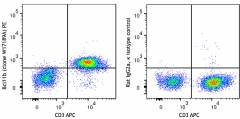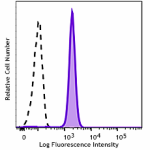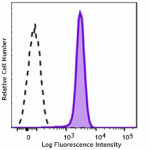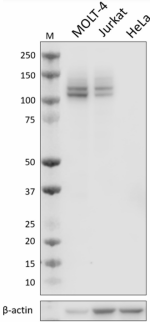- Clone
- W17189A (See other available formats)
- Regulatory Status
- RUO
- Other Names
- CTIP-2, CTIP2, hRIT1-alpha, SMARCM2
- Isotype
- Rat IgG2a, κ
- Ave. Rating
- Submit a Review
- Product Citations
- publications

-

Human peripheral blood mononuclear cells were treated with True-Nuclear™ Transcription Factor Buffer Set (Cat. No. 424401) then stained with anti-human Bcl11b (clone W17189A) left) PE (left) or rat IgG2a, κ PE isotype control (right). Cells were costained with anti-human CD3 APC. Data was gated on lymphocyte populations. -

Jurkat cells were treated with True-Nuclear™ Transcription Factor Buffer Set (Cat. No. 424401) then stained with anti-human Bcl11b (clone W17189A) PE (filled histogram) or rat IgG2a, κ PE isotype control (open histogram).
| Cat # | Size | Price | Quantity Check Availability | Save | ||
|---|---|---|---|---|---|---|
| 384503 | 25 tests | £133 | ||||
| 384504 | 100 tests | £262 | ||||
The transcription factor, Bcl11b, is expressed in the thymus, mainly T cells. It is indispensable for T lineage development. When Bcl11b was deleted, T cells from all developmental stages acquired NK cell properties and concomitantly lost or decreased T cell-associated gene expression. These induced T-to-natural killer (ITNK) cells, which were morphologically and genetically similar to conventional NK cells, killed tumor cells in vitro, and effectively prevented tumor metastasis in vivo. Therefore, ITNKs may represent a new cell source for cell-based therapies.
Product DetailsProduct Details
- Verified Reactivity
- Human
- Antibody Type
- Monoclonal
- Host Species
- Rat
- Immunogen
- RP 1-250 (generated by E. coli)
- Formulation
- Phosphate-buffered solution, pH 7.2, containing 0.09% sodium azide and BSA (origin USA)
- Preparation
- The antibody was purified by affinity chromatography and conjugated with PE under optimal conditions.
- Concentration
- Lot-specific (to obtain lot-specific concentration and expiration, please enter the lot number in our Certificate of Analysis online tool.)
- Storage & Handling
- The antibody solution should be stored undiluted between 2°C and 8°C, and protected from prolonged exposure to light. Do not freeze.
- Application
-
ICFC - Quality tested
- Recommended Usage
-
Each lot of this antibody is quality control tested by intracellular immunofluorescent staining with flow cytometric analysis. For flow cytometric staining, the suggested use of this reagent is 5 µL per million cells in 100 µL staining volume or 5 µL per 100 µL of whole blood. It is recommended that the reagent be titrated for optimal performance for each application.
- Excitation Laser
-
Blue Laser (488 nm)
Green Laser (532 nm)/Yellow-Green Laser (561 nm)
- RRID
-
AB_2936634 (BioLegend Cat. No. 384503)
AB_2936634 (BioLegend Cat. No. 384504)
Antigen Details
- Structure
- 894 amino acids with molecular weight of 96 kD. It encodes a C2H2-type zinc finger protein and is closely related to BCL11A.
- Distribution
-
Nucleus
- Function
- Tumor-suppressor protein involved in T-cell lymphomas. A key regulator of both differentiation and survival during thymocyte development.
- Interaction
- Interacts with TFCOUP1, SIRT1, ARP1, and EAR2
- Antigen References
-
- Liu P, et al. 2011. Immunol Rev. 238:138-49.
- Ikawa T, et al. 2010. Science. 329:93-6.
- Li L, et al. 2010. Science. 329:89-93.
- Li P, et al. 2010. Science. 329:85-9.
- Tydell CC, et al. 2007. J Immunol. 179:4238.
- Avram D, et al. 2002. Biochem J. 368:555-63.
- Gene ID
- 19882 View all products for this Gene ID
- UniProt
- View information about Bcl11b on UniProt.org
Related Pages & Pathways
Pages
Related FAQs
- What type of PE do you use in your conjugates?
- We use R-PE in our conjugates.
Other Formats
View All Bcl11b Reagents Request Custom Conjugation| Description | Clone | Applications |
|---|---|---|
| PE anti-human Bcl11b | W17189A | ICFC |
| Purified anti-human Bcl11b | W17189A | ICFC,IHC-P,WB |
Compare Data Across All Formats
This data display is provided for general comparisons between formats.
Your actual data may vary due to variations in samples, target cells, instruments and their settings, staining conditions, and other factors.
If you need assistance with selecting the best format contact our expert technical support team.
-
PE anti-human Bcl11b

Human peripheral blood mononuclear cells were treated with T... 
Jurkat cells were treated with True-Nuclear™ Transcription F... -
Purified anti-human Bcl11b

Human peripheral blood mononuclear cells were treated with T... 
Jurkat cells were treated with True-Nuclear™ Transcription F... 
Whole cell extracts (15 µg total protein) from the indicated... 
IHC staining using purified anti-human Bcl11b (clone W17189A...
 Login / Register
Login / Register 












Follow Us